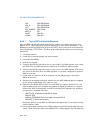
8-34 Vol. 3
MULTIPLE-PROCESSOR MANAGEMENT
during power-up and initialization is 8 bits. Bits 2:1 form a 2-bit physical package
identifier (which can also be thought of as a socket identifier). In systems that
configure physical processors in clusters, bits 4:3 form a 2-bit cluster ID. Bit 0 is used
in the Intel Xeon processor MP to identify the two logical processors within the
package (see
Section 8.9.3, “Hierarchical ID of Logical Processors in an MP System”).
For Intel Xeon processors that do not support Intel Hyper-Threading Technology, bit
0 is always set to 0; for Intel Xeon processors supporting Intel Hyper-Threading
Technology, bit 0 performs the same function as it does for Intel Xeon processor MP.
For more recent multi-core processors, see Section 8.9.1, “Hierarchical Mapping of
Shared Resources” for a complete description of the topological relationships
between logical processors and bit field locations within an initial APIC ID across Intel
64 and IA-32 processor families.
Note the number of bit fields and the width of bit-fields are dependent on processor
and platform hardware capabilities. Software should determine these at runtime.
When initial APIC IDs are assigned to logical processors, the value of APIC ID
assigned to a logical processor will respect the bit-field boundaries corresponding
core, physical package, etc. Additional examples of the bit fields in the initial APIC ID
of multi-threading capable systems are shown in
Section 8.9.
For P6 family processors, the APIC ID that is assigned to a processor during power-
up and initialization is 4 bits (see
Figure 8-2). Here, bits 0 and 1 form a 2-bit
processor (or socket) identifier and bits 2 and 3 form a 2-bit cluster ID.
Figure 8-2. Interpretation of APIC ID in Early MP Systems
0
Processor ID
17 432
Cluster
Reserved
0
Processor ID
17 4325
Cluster
Reserved
APIC ID Format for Intel Xeon Processors that
APIC ID Format for P6 Family Processors
0
do not Support Intel Hyper-Threading Technology


















